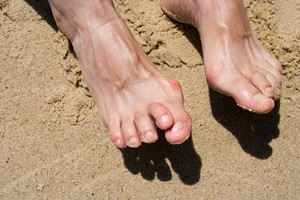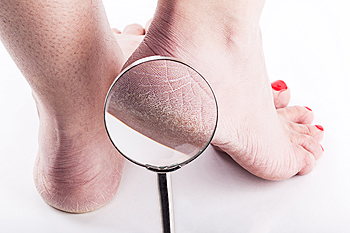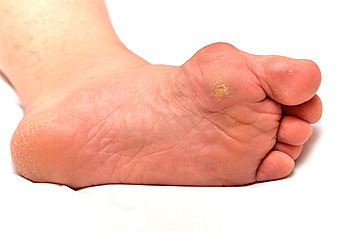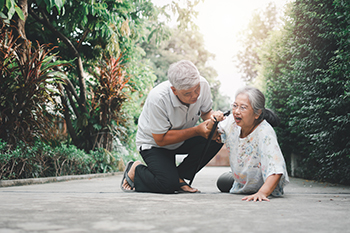Connect With Us
Blog
Items filtered by date: May 2022
What Are Hammertoes?
Hammertoes are painful deformities that frequently form on the second, third, or fourth toe. The condition is often caused by an issue in foot mechanics. This can be caused by the person’s specific gait or the manner in which they walk, or by shoes that do not comfortably fit the deformity. Hammertoes can be formed after wearing shoes that are too narrow or short for the foot or have excessively high heels. Shoes that are not properly sized will force the toes into a bent position for long periods of time. This can cause the muscles to shorten and toes to bend into the deformity of a hammertoe.
Hammertoe can also be caused by complications from rheumatoid arthritis, osteoarthritis, trauma to the foot, heredity, or a cerebral vascular accident. Pain and difficult mobility of the toes, deformities, calluses, and corns are all symptoms of a hammertoe.
Someone who suspects they have the symptoms of a hammertoe should consult with a physician—particularly a podiatrist. Podiatrists diagnose and treat complications of the foot and ankle. If the podiatrist discovers that the affected toes are still flexible, treatment for the hammertoe may simply involve exercise, physical therapy, and better-fitting shoes. Treatment for hammertoes typically involves controlling foot mechanics, such as walking, through the use of customized orthotics.
For more serious cases in which the toes have become inflexible and rigid, surgery may be suggested. During the operation, the toe would receive an incision to relieve pressure on the tendons. A re-alignment of the tendons may then be performed by removing small pieces of bone to straighten the toe. In some cases, the insertion of pins is needed to keep the bones in the proper position as the toe heals. The patient is usually allowed to return home on the same day as the surgery.
If surgery is performed to repair a hammertoe, following the postoperative directions of your doctor is essential. Directions may include several stretches, picking up marbles with your toes, or attempting to crumple a towel placed flat against your feet. Wear shoes that have low heels and a wide amount of toe space to maintain comfort. Closed-toe shoes and high heels should be avoided. Shoes with laces allow the wearer to adjust how fitted he or she may want the shoes to be and also allow for greater comfort. To provide adequate space for your toes, select shoes that have a minimum of one-half inch of space between the tip of your longest toe and the inside of the shoe. This will also relieve pressure on your toes and prevent future hammertoes from forming.
Other preventative measures that can be taken include going shopping for new shoes in the middle of the day. Your feet are its smallest in the morning and swell as the day progresses. Trying on and purchasing new shoes midday will give you the most reliable size. Be sure to check that the shoes you purchase are both the same size. If possible, ask the store to stretch out the shoes at its painful points to allow for optimum comfort.
What Causes a Hammertoe?

A hammertoe is a common deformity where a toe bends upward at the middle joint and gets stuck in that position. The top of the toe bends forward so it looks like a hammer. As time passes, the joint may get more rigidly bent and it can be painful and possibly lead to difficulty in walking and maintaining balance. Hammertoes can be inherited, with those with flatter feet and longer metatarsals (or middle bones of the feet) being more at risk. They can also be associated with a medical condition, such as diabetes. However, most often hammertoes develop from an imbalance within the toe structure. Usually something that forces extra weight to be put on the forefoot and toes (like tight shoes or high heels) can lead to hammertoes. The small muscles on the bottom of the foot get weaker than the larger muscles on the top of the foot and the toe does not bend or flex. Early detection and conservative treatment can help prevent the need for hammertoe surgery. Such intervention can be as simple as changing footwear to providing extra room for the toes, avoiding narrow, tight, and heeled shoes, using custom orthotics to off-load extra weight and strain towards the forefoot. If you suffer from a hammertoe, it is suggested you consult with a podiatrist to find the best treatment plan.
Hammertoe
Hammertoes can be a painful condition to live with. For more information, contact Dr. David Ungar from Personal Foot Care. Our doctor will answer any of your foot- and ankle-related questions.
Hammertoe is a foot deformity that affects the joints of the second, third, fourth, or fifth toes of your feet. It is a painful foot condition in which these toes curl and arch up, which can often lead to pain when wearing footwear.
Symptoms
- Pain in the affected toes
- Development of corns or calluses due to friction
- Inflammation
- Redness
- Contracture of the toes
Causes
Genetics – People who are genetically predisposed to hammertoe are often more susceptible
Arthritis – Because arthritis affects the joints in your toes, further deformities stemming from arthritis can occur
Trauma – Direct trauma to the toes could potentially lead to hammertoe
Ill-fitting shoes – Undue pressure on the front of the toes from ill-fitting shoes can potentially lead to the development of hammertoe
Treatment
Orthotics – Custom made inserts can be used to help relieve pressure placed on the toes and therefore relieve some of the pain associated with it
Medications – Oral medications such as anti-inflammatories or NSAIDs could be used to treat the pain and inflammation hammertoes causes. Injections of corticosteroids are also sometimes used
Surgery – In more severe cases where the hammertoes have become more rigid, foot surgery is a potential option
If you have any questions please contact our office located in Farmington, MI . We offer the newest diagnostic and treatment technologies for all your foot and ankle needs.
Solutions for Cracked Heels
Cracked heels may make you want to think twice about showing off your feet in warmer weather. However, cracked heels may be harmful to more than just the appearance of your feet. If deep fissures and cracks develop in your heels, they may make walking and standing painful for you. Additionally, these openings make way for germs to enter through your skin and cause infection.
There are several different causes of cracked heels. One of the most common reasons for this ailment is dry skin. This problem may make your keeps feel rough tight and itchy. Dry skin may be caused by cold air, extremely hot water, harsh soaps, and aging. Skin disorders such as eczema and psoriasis may eventually lead to dry skin. In some cases, complications may arise from cracked heels. Some of these complications are a loss of feeling in the heel, cellulitis, or a diabetic foot ulcer.
There are ways you can try to prevent getting cracked heels. One of the best ways to do so is to avoid wearing flip flops and sandals because these shoes increase your risk of drying out your feet. You should also avoid wearing shoes with a tall skinny heel, because these shoes cause your heel to expand sideways. At night, you should slather on a thick moisturizing cream on your feet and then cover them in socks to keep your feet moisturized overnight. Drinking water to stay hydrated is also a good way to ensure that your skin doesn’t become dry.
If you suffer from a severe case of cracked feet, you should make an appointment with your podiatrist to see what treatment methods are best for you.
The Ugly Truth About Cracked Heels

When your heels have developed cracked skin, they can feel unattractive, to say the least. The texture of your heels becomes rough, the skin is dry and thick, and occasionally, you will have a yellow or brown callus along the heel. You might notice cracks that can range from small to deep. Bad cracks can bleed, become inflamed, and even get infected. Those who have the back of their foot exposed in open-heeled shoes are said to be more prone to developing cracked heels. Sometimes cracked heels can signal an underlying condition such as diabetes or hypothyroidism. These illnesses can reduce sweat production and make feet drier. Some skin conditions, like eczema or psoriasis, can contribute to having cracked heels as well. At-home treatments include regular cleaning, drying, and moisturizing of the feet, and removing some of the dry skin on the heel with a pumice stone. Visit a podiatrist for an assessment of your cracked heels and for expert advice and treatment.
If the skin on your feet starts to crack, you may want to see a podiatrist to find treatment. If you have any concerns, contact Dr. David Ungar from Personal Foot Care. Our doctor can provide the care you need to keep you pain-free and on your feet.
Cracked Heels
It is important to moisturize your cracked heels in order to prevent pain, bleeding, and infection. The reason cracked heels form is because the skin on the foot is too dry to support the immense pressure placed on them. When the foot expands, the dry skin on the foot begins to split.
Ways to Help Heal Them
- Invest in a good foot cream
- Try Using Petroleum Jelly
- Ease up on Soaps
- Drink Plenty of Water
Ways to Prevent Cracked Heels
- Moisturize After Showering
- Skip a Shower
- Keep Shower Water Lukewarm
- Don’t Scrub Your Feet
If you are unsure how to proceed in treating cracked heels, seek guidance from a podiatrist. Your doctor will help you with any questions or information you may need.
If you have any questions, please feel free to contact our office located in Farmington, MI . We offer the newest diagnostic and treatment technologies for all your foot care needs.
Everything You Need to Know About Corns
Corns are hard and thick areas of skin that form as a result of constant rubbing, friction, or pressure on the skin. They are patches of dead skin with a small plug toward the center. They may appear on the tops and sides of toes and can make walking painful.
Soft corns are typically thinner with a white color and rubbery texture. Soft corns tend to appear between the toes. Seed corns are another type of corn that appear in clusters and can be tender if they are on a weight-bearing part of the foot. Seed corns usually appear on the bottom of the foot and are likely caused by a blockage in sweat ducts.
While corns and calluses are somewhat similar, calluses are a bit different. Calluses are a patch of dead skin that can occur anywhere on the body. In comparison to corns, calluses are usually a bit larger in size. However, both corns and calluses are caused by increased friction on the skin.
There are some risk factors that may increase your chances of developing corns and calluses. If you have bunions, hammertoe, or a bone spur, you are more likely to develop a corn or callus on your foot.
While Corns and Calluses tend to disappear when the friction to the affected area ceases, the help of a podiatrist may be useful in the removal process. It is important to remove the dead skin around the area and this may be done in a few different ways. Moisturizing creams may be helpful in softening and removing the dead skin around the callus. You should never use razors or other pedicure equipment to remove your corns. Doing this may worsen your corn or callus and cause infection.
In some cases, corns and calluses may be caused by abnormal foot structure or walking motion. In such a case, you should seek a podiatrist’s assistance in order to correct the issue.
What to Do About a Corn on the Pinky Toe?

Corns, also called clavus, can appear on the toes and feet. The most common place a corn develops is on the side of the pinky toe. A corn is a whitish-yellow hardened patch of dead skin that becomes raised, inflamed, and painful due to repeated exposure to pressure and rubbing. This can happen if shoes are too tight or narrow and rub on the side of the pinky toe, prolonged time spent on the feet, structural problems of the feet or toe bones, or an abnormal gait. Those with diabetes, arthritis, and the elderly are more apt to develop corns. Prevention of corns includes wearing properly fitted shoes, resting feet, keeping feet clean, dry, and moisturized, and trimming toenails regularly. A corn on the pinky toe can be treated at home by soaking the foot in warm water, allowing the corn to soften and lift and/or drying the foot after the soak, and filing it gently with a pumice stone. Medicated corn pads, often containing salicylic acid, can be purchased from drug stores and these provide cushioning of the corn while directly applying medication to dissolve the corn. If these simple home remedies don't help or the corn is unusually painful or infected, it is suggested that you see a podiatrist who can use a properly sterilized surgical blade to shave the dead skin and remove the corn.
Corns can make walking very painful and should be treated immediately. If you have questions regarding your feet and ankles, contact Dr. David Ungar of Personal Foot Care. Our doctor will treat your foot and ankle needs.
Corns: What Are They? And How Do You Get Rid of Them?
Corns are thickened areas on the skin that can become painful. They are caused by excessive pressure and friction on the skin. Corns press into the deeper layers of the skin and are usually round in shape.
Ways to Prevent Corns
There are many ways to get rid of painful corns such as:
- Wearing properly fitting shoes that have been measured by a professional
- Wearing shoes that are not sharply pointed or have high heels
- Wearing only shoes that offer support
Treating Corns
Although most corns slowly disappear when the friction or pressure stops, this isn’t always the case. Consult with your podiatrist to determine the best treatment option for your case of corns.
If you have any questions please feel free to contact our office located in Farmington, MI . We offer the newest diagnostic and treatment technologies for all your foot and ankle needs.
Wounds That Don't Heal Need to Be Checked
Falls Prevention
Elderly Americans are very susceptible to falls as they get older. Everyone experiences decreases in flexibility, balance, strength, and the senses as they age. This correlates to some eye-opening statistics. 1 in 4 Americans aged 65 and older fall each year. An elderly American is being treated for a fall in an emergency room every 11 seconds, and every 19 minutes, an older person dies from falling. In light of these striking statistics, one can see the importance of taking steps to prevent falls.
Finding an exercise program for the elderly is an excellent way to reduce the likelihood of falls. Look for an exercise program that improves strength and balance. Elderly people who live a more sedentary lifestyle, with little physical activity, are at an increased risk of falling. Wearing well-fitted footwear that provides good foot support and cushion will help prevent falls from poorly fitted shoes. Talking to a podiatrist about your susceptibility to falls and about inspecting your prescriptions will help to avoid any medication that could make falls more likely. Due to a decline in the senses among the elderly, having your eyes and hearing checked is recommended.
Around half of all falls occur in the household. Removing tripping hazards in the home and making it more accommodating to older persons can significantly reduce falls. Some notable household changes include increasing lighting around the house, installing grab bars in the shower and bathroom, and making sure the floor is clear of clutter. Other smart options include installing a shower chair, using rubber-bottomed rugs, and placing railings on both sides of stairwells.
Finally, discuss with a doctor and your family about your fear of falling. This will help to increase awareness among the population on the need for fall prevention. A lack of awareness on the matter, and a downplaying of importance are what increase the risks of falling. Following these tips can help to reduce the risk for yourself and your loved ones.
Ways to Prevent Falls in the Elderly

According to the CDC, one out of four seniors over 65 experiences a fall, and the odds are that once you have fallen, it will happen again. This often occurs as the result of diminishing balance, mobility and coordination as you age. Five simple ways to help prevent falls, and the injuries that may follow, include removing tripping hazards around the home, making stairs and bathrooms safer, wearing proper shoes and slippers, using a cane or walker, and doing exercises that both strengthen legs and feet and improve balance and coordination. First, it is suggested that you remove area rugs or mats that can be tripped over or that slide too easily, and clear hallways and walkways of clutter or other objects. Second, have railings installed on all stairways, including those on porches or home entry areas. Also, add grab bars to bathroom tubs and showers and make sure to use non-slip mats. Third, find shoes that provide support and fit well. Avoid going barefoot and walking around in socks at home. Instead get shoes and slippers with non-skid soles for safety both inside and out of the house. Fourth, it is amazing how many seniors refuse to use a walking aid out of vanity, but using a cane or walker is one of the best ways to avoid falls. Finally, see your podiatrist for information on how to strengthen your ankles and feet with exercises you can do at home. A podiatrist can answer any questions you may have on ways to prevent falling.
Preventing falls among the elderly is very important. If you are older and have fallen or fear that you are prone to falling, consult with Dr. David Ungar from Personal Foot Care. Our doctor will assess your condition and provide you with quality advice and care.
Every 11 seconds, an elderly American is being treated in an emergency room for a fall related injury. Falls are the leading cause of head and hip injuries for those 65 and older. Due to decreases in strength, balance, senses, and lack of awareness, elderly persons are very susceptible to falling. Thankfully, there are a number of things older persons can do to prevent falls.
How to Prevent Falls
Some effective methods that older persons can do to prevent falls include:
- Enrolling in strength and balance exercise program to increase balance and strength
- Periodically having your sight and hearing checked
- Discuss any medications you have with a doctor to see if it increases the risk of falling
- Clearing the house of falling hazards and installing devices like grab bars and railings
- Utilizing a walker or cane
- Wearing shoes that provide good support and cushioning
- Talking to family members about falling and increasing awareness
Falling can be a traumatic and embarrassing experience for elderly persons; this can make them less willing to leave the house, and less willing to talk to someone about their fears of falling. Doing such things, however, will increase the likelihood of tripping or losing one’s balance. Knowing the causes of falling and how to prevent them is the best way to mitigate the risk of serious injury.
If you have any questions, please feel free to contact our office located in Farmington, MI . We offer the newest diagnostic and treatment technologies for all your foot care needs.
Foot Therapy for Sports Injuries
Foot Therapy for Sports Injuries
Athletes are used to engaging in high-intensity workouts. Consequently, athletes are at an increased risk for enduring foot or ankle injuries. The most common way to treat these types of injuries is the RICE method (Rest, Ice, Compression, and Elevation). However, braces and casts may be required in some cases. If you are suffering from any of these injuries, it is best that you seek help from your podiatrist right away.
Achilles Tendinitis
Achilles tendinitis is a type of overuse injury of the Achilles tendon, which is the tendon connecting the calf muscles to the heel. This type of injury commonly occurs in runners who increase the intensity of their workouts. Symptoms for this condition start off as a mild ache in the back leg or above the heel. Some people experience tenderness around the area in the morning, however this feeling tends to improve over time. If you suspect you have Achilles tendinitis, you doctor may order an x-ray to show whether your Achilles tendon has calcified. Common treatment options for this condition include rest, ice, exercise, and non-steroidal anti-inflammatory medication.
Plantar Fasciitis
Plantar Fasciitis is a condition that is commonly found in women. It is a painful condition that occurs when the bands of tissue that connect the heel to the toes become inflamed. Symptoms for plantar fasciitis are heel pain that worsens in the morning and improves throughout the day with activity. Your podiatrist will diagnose plantar fasciitis by checking for tender areas on your foot. In rare cases, an x-ray may be required for a more thorough examination. There are various treatment options that may be used to help someone with this ailment. Depending on the specific case, some of these options include: physical therapy, shockwave therapy, and in rare cases, surgery.
Stress Fractures
Stress fractures are tiny cracks in the bone that occur due to repetitive force. These fractures are typically the result of overuse injuries such as repeatedly running and jumping. Symptoms of a stress fracture include pain when exercising, tenderness, and mild swelling. To diagnose a stress fracture, your doctor will likely ask you a series of questions about your overall health and the activities you are involved in. Next, an x-ray will likely be performed to check for the fracture. In some cases, fractures don’t appear on x-rays until weeks afterward. In these cases, an MRI or a bone scan may be required. Typical stress fractures may be treated by resting the area and taking a break from highly intense activities.
Ankle Sprain
Ankle sprains occur when the ligaments that support the ankle are stretched far beyond their limits. These injuries occur when you roll, twist, or turn your ankle in an awkward way. Ligaments are essential in helping us move around because they are responsible for stabilizing the joints. Usually, sprained ankles occur due to ligaments on the outer part of the ankle becoming stretched. Symptoms of ankle sprains are swelling, bruising, instability of the ankle, and restricted range of motion. Normally, when people sprain their ankle, they will hear a popping sound during the injury. Depending on the severity, ankle sprains are graded based on how much damage has occurred to the ligaments. Grade 1 is mild, grade 2 is moderate, and grade 3 is severe.

